Study Abroad in Perugia, Italy with Full Immersion
A Student's Guide to Cultural Immersion in Europe
Article and photos by Katie Tozer
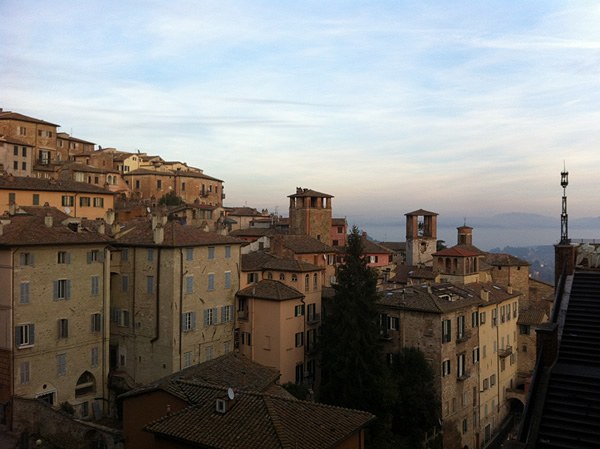
|
|
One angle of the town of Perugia, Italy.
|
So you want to study abroad in Europe? The temptation to add all the major European cities to your to-do list and rattle off your country count when friends call from back home can be strong, but you would do well to resist it. Country-counting may seem like an exciting challenge, but it’s an expensive, shallow, and exhausting way to see the world. A more satisfying semester abroad is primarily spent engaging with the community you’ve been blessed to join for however short a time. Chances are that if travelling is really important to you, you will make it back to many other European cities one day. You are less likely to ever be a temporary resident of Europe again.
I juggled these ways of thinking when I studied in Perugia with the Umbra Institute in the spring of 2014. Perugia was the biggest city I had ever lived in — and therefore a nice alternative to its larger neighbors, Florence and Rome. I was looking for an Italian cultural experience, access to the rest of Italy, and a place that might feel like home. I found all that and more in Perugia. Fortunately, the program I attended and the people associated pushed me to make the most of our city and shave down an ambitious list of sights to see elsewhere.
With the benefit of hindsight, I now wish I had prioritized Perugia even more, so I created this resource for future travelers. I’ve divided my advice and anecdotes into three sections:
-
Live Like a Local: Get to Know Your City,
or what to do in town
-
Vacation: Find Out Where Locals Go,
advice on what’s within reach out-of-town
-
Save Money While Seeing it All,
some practical tips that anyone can use
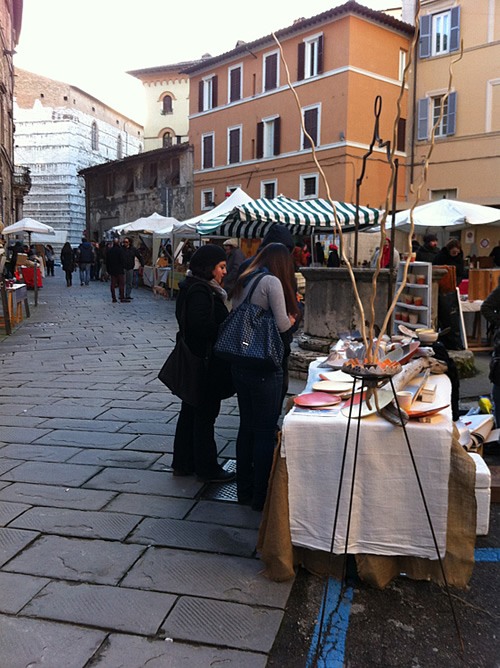
|
|
Shopping at the monthly artisan market in Perugia.
|
Live Like a Local: Get to Know Your City
-
Meet People — Whether you can attempt to say Buongiorno, Buenos Dias, or whatever the appropriate greeting is in your host country, people will appreciate that you are trying. The alimentari (grocery) owner down the street in Perugia taught me many words simply because I tried to speak Italian with him. There are also undoubtedly English speakers who can be essential resources for you, like the staff at your program or fellow students. Get to know these people. They will have tips on everything that’s to come in the rest of this article.
-
Visit Markets — While I love my alimentari, there’s something romantic about walking to a piazza (square) filled with fruits and vegetables from the surrounding countryside, like Florent’s benefactor in The Belly of Paris, the novel by Emile Zola. You can find more than food at local markets, as well. Perugia offers markets dedicated to antiques, artisans, and other special occasions. I once met two travelers at a jewelry stall at one of these markets who had taken a year off to backpack up the Apennines, the mountain range that forms the spine of Italy. They offered advice on couchsurfing, agriturismi (farm stays), and inspired my next trip. For more on markets and Perugia specifically, you can check the “What to Do” Calendar at inperugia.com.
-
Attend Community Gatherings — When in Rome (or near enough in this case) do as the Romans do and go to church! You’ll get to stop imagining what music might sound like in those spectacular cathedrals and actually hear it, augment your language acquisition, hear music performed, and simultaneously get an authentic shot of local culture. Attending a City Hall meeting or public forum wouldn’t be a bad idea either. I’ve heard that some London parks hold free, public, and volunteer-speaker lectures. These underutilized tools await the thoughtful traveler for the low cost of your time and attention.
-
Experience Local Arts and Culture — Most European cities have museums, galleries, concerts, and theaters. It doesn’t have to be La Scala or the Louvre to bring you joy — and actually, La Scala would feel less authentic when everyone in your box speaks English. I saw a symphony from a red velvet-lined box in Perugia for 20€. My school had Museum Passes for students that made it possible for me to see Peruginos, Vanuccis, a Raphael, and a network of catacombs for free.
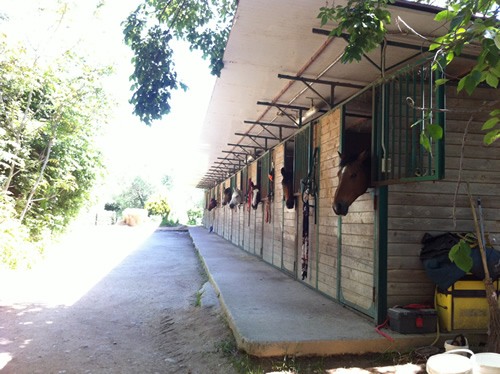
|
|
The stables at Umbrian vineyard Terre Margaritelli.
|
Vacation: Find Out Where Locals Go in Perugia
-
Look for Classes and Tours — At
Umbra, the staff had a long table set up outside the library
with stacks of brochures and pamphlets advertising local or
near-local attractions. These resources helped me find hidden
treasures like Chef Jennifer’s
private cooking classes and wine tastings (“Life…Italian
Style”), a visit to Lake Trasimeno, active proponents of the Slow
Food Movement, and the Perugina Chocolate Factory, famous
for their Baci chocolates. If I had come to Italy with all my
weekends pre-planned, I would have missed out on these opportunities.
What assets are in your community? I bet you can find language
exchange happy hours, dancing classes, microbrewery tours, and
much more.
-
Visit National and Regional Parks — Just like the U.S., European countries have protected wildlife areas and parks. If you feel the itch to venture outside the city, these are great places to go. You can get to some via public transportation. A close park is great for a day trip, hike, or picnic. Some parks on the coast have scuba diving and beaches, in the mountains you could ski! From Perugia, I was able to visit Lake Trasimeno Park multiple times. Visiting your host country’s parks gives you a chance to connect to the land and nature of the nation, while escaping hoards of rushing tourists.
-
Go to Nearby Cities — I want to be clear; I’m not saying I wish I had never left Perugia. One of the reasons I chose Perugia was because of its proximity to sites like Florence and Rome. However, there is a big difference between going from Perugia to Florence and from Perugia to Budapest (no offense, Budapest, I have heard you are fabulous). Traveling to nearby cities gives you quite a few advantages: you’re familiar with the language and currency, you can spend a longer period of time, you can go more than once, trains are more flexible and affordable than planes, and all the lowered stress will give you more energy to see and do what you went for more on your own terms and in your own time! I went to Rome three times during my time in Italy. The first time, I tried to see all the highlights in two days: the Colosseum, Vatican, Roman Forum, Pantheon, Trevi Fountain, etc. I spent the next week nursing my feet back to normal. Then, the second time, I revisited some of the same sites at a more leisurely pace and enjoyed them so much more. I was able to put the map down and look at storefronts. Want to climb to the top of Saint Peter’s Cathedral? Sure, we have time. I even was able to see an AS Roma soccer game and I realized then and there that I had not actually seen Rome the first time. The game was the first time I was actually around Romans.
-
Embrace the Stay-Cation — relax on the lawn, park, or piazza down the street from your place. No tickets, no travel, no hassle. Other stay-cation activities might include indulging in the nightlife or going to a festival. If people are traveling from all over the world to the place where you’re living, why would you leave every weekend? I remember spending one Sunday on the lawn outside a cathedral as summer gained on spring and I ran into a fellow Perugian student who showed me a sandwich shop and introduced me to more foreign friends!
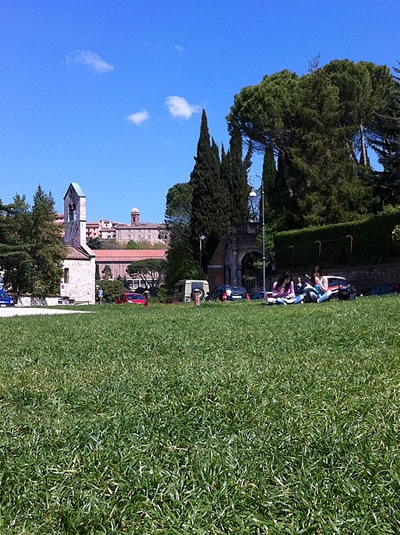
|
|
The lawn at San Francesco, Perugia.
|
Save Money While Seeing it All
-
Research Your Bank’s Policies — Is there an ATM nearby that you can use for a low fee? Should you use a credit card or a debit card? Should you open a temporary account overseas? How do I know when the exchange rate is favorable? Answering these questions could save you a lot of money in the long run, but it can be a headache figuring it all out. Go to your bank and ask program staff for advice. Lastly, carry cash. I found Europe to be much less card-happy than the States.
-
Take Free Walking Tours — Wherever you may go, but in your own city, too! There are tons of these, usually led by local guides who give you tons of friendly insight (they know they need to earn their tips).
-
Transportation Life Hacks —
Know the rules! I once had to pay a 30€ fine for misusing the
bus ticket validator. If you plan on doing a lot of train travel,
I would buy a Eurail Pass. These lend you flexibility
and save you money anytime you take an expensive train or more
than one ride in one day. Keep in mind that locals are invaluable
resources (for example, in Spain, many recommend buses over
trains). If you’re going to be flying, check out Kayak.com and
the sites listed on our budget
airline travel page for
other budget airlines. As always, read ALL the terms and conditions
for any given metasearch engine.
-
Limit International Travel — Airports are typically quite a hike away. In Rome, you have to take the 14€ “Leonardo Express” from the city to the airport. And good luck figuring out how to get to your destination on the other end. If you have not yet been convinced that there is more than enough to do, see, and learn from your host city, consider how much you would save by spending time at your temporary home.
-
Plan Your Own Travel — Eschewing trip promotions marketed specifically toward study abroad students will help you grow, boost your confidence, lower the price, and give you more flexibility. I went to Switzerland with one such group and was underwhelmed by the guides, accommodations, and transportation for which I had paid 200€.
-
Stay Organized — Plan ahead. Once, I left Italy and had to book a night in Rome to make the “cheap” flight scheduled for the morning. After that, I started making spreadsheets for each trip, near or far. That extra step ensured we never booked a train for the wrong day, forgot to find a hostel, or double booked. My favorite resources were Lonely Planet, Rough Guides, and Trip Advisor.
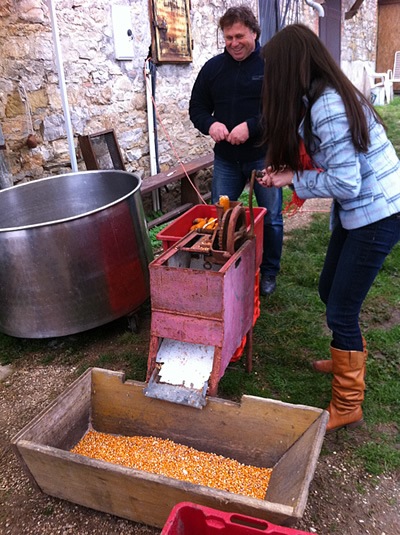
|
|
Flavio Orsini teaching us to shuck corn on his Slow Food farm.
|
Full Immersion as a Student in Europe
Many programs do prioritize immersion in the local culture for their students, but it’s hard to search for such an angle. I would suggest prioritizing your criteria and starting your search with the nonnegotiables — whether location, subject, cost, or some other key criteria. Don’t assume you have to sacrifice culture for course credits. You are making a huge investment when studying abroad in Europe and you do not have to settle.
Use the resources on your campus to search for the program that fits best your interests and needs. The internet is a black hole that can lose and confuse you, so reach for the life raft that is your university’s Study Abroad Counselor. With such information and support, keeping an eye out for programs with a cultural bent can help you find an experience like mine.
I studied at the Umbra Institute and applied through Arcadia University’s College of Global Studies. Arcadia’s website has an “Engage with the Culture” tab for each program that offers examples of local trips and tours that Arcadia sponsors. Look for something of this nature with the program you think is right for you and you can bet you’ll get the most out of your host city. You can search Arcadia’s program listings on Arcadia Study Abroad website.
Interested in Perugia specifically? Check out the University for Foreigners in addition to the fine Umbra Institute.
|
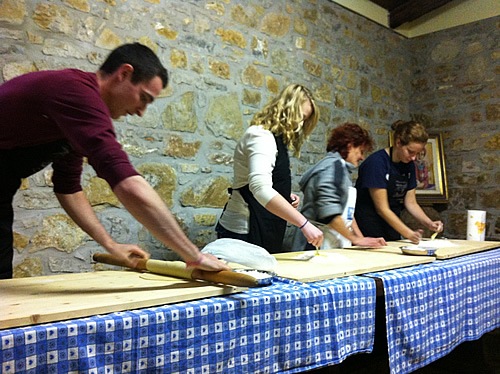
|
|
Arcadia students make fresh pasta with the Orsini family
|
Katie Tozer grew up outside Chicago and attended DePauw University in Indiana, where she studied English Writing and traveled to Ecuador, Italy, and India. In Italy, she wrote for inperugia.com, an online resource for student travelers to the little city. She is now beginning a year as a teaching assistant in New York City, continuing to treat every experience like an adventure abroad, and reflecting on how much traveling has taught her.
|
